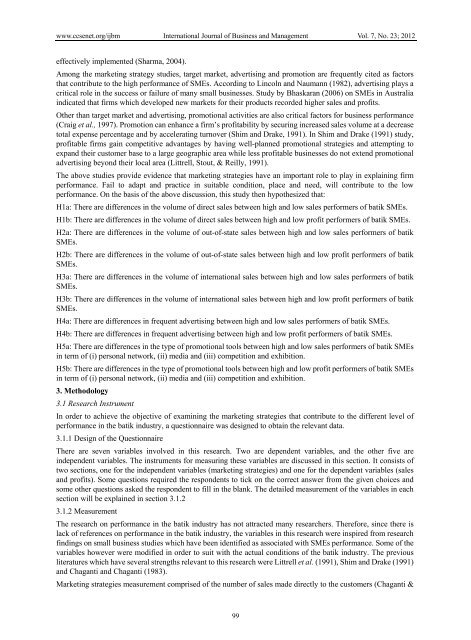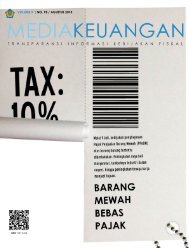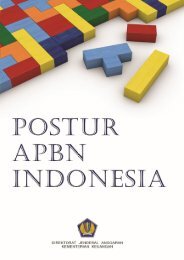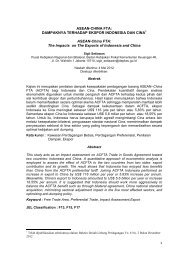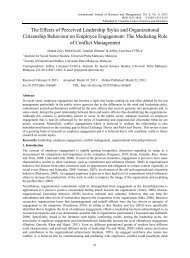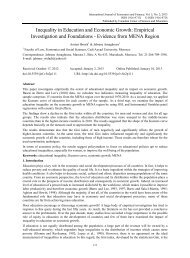Marketing%20Strategies%20and%20the%20Difference%20Level%20of%20Sales%20and%20Profits
Marketing%20Strategies%20and%20the%20Difference%20Level%20of%20Sales%20and%20Profits
Marketing%20Strategies%20and%20the%20Difference%20Level%20of%20Sales%20and%20Profits
Create successful ePaper yourself
Turn your PDF publications into a flip-book with our unique Google optimized e-Paper software.
www.ccsenet.org/ijbm International Journal of Business and Management Vol. 7, No. 23; 2012<br />
effectively implemented (Sharma, 2004).<br />
Among the marketing strategy studies, target market, advertising and promotion are frequently cited as factors<br />
that contribute to the high performance of SMEs. According to Lincoln and Naumann (1982), advertising plays a<br />
critical role in the success or failure of many small businesses. Study by Bhaskaran (2006) on SMEs in Australia<br />
indicated that firms which developed new markets for their products recorded higher sales and profits.<br />
Other than target market and advertising, promotional activities are also critical factors for business performance<br />
(Craig et al., 1997). Promotion can enhance a firm’s profitability by securing increased sales volume at a decrease<br />
total expense percentage and by accelerating turnover (Shim and Drake, 1991). In Shim and Drake (1991) study,<br />
profitable firms gain competitive advantages by having well-planned promotional strategies and attempting to<br />
expand their customer base to a large geographic area while less profitable businesses do not extend promotional<br />
advertising beyond their local area (Littrell, Stout, & Reilly, 1991).<br />
The above studies provide evidence that marketing strategies have an important role to play in explaining firm<br />
performance. Fail to adapt and practice in suitable condition, place and need, will contribute to the low<br />
performance. On the basis of the above discussion, this study then hypothesized that:<br />
H1a: There are differences in the volume of direct sales between high and low sales performers of batik SMEs.<br />
H1b: There are differences in the volume of direct sales between high and low profit performers of batik SMEs.<br />
H2a: There are differences in the volume of out-of-state sales between high and low sales performers of batik<br />
SMEs.<br />
H2b: There are differences in the volume of out-of-state sales between high and low profit performers of batik<br />
SMEs.<br />
H3a: There are differences in the volume of international sales between high and low sales performers of batik<br />
SMEs.<br />
H3b: There are differences in the volume of international sales between high and low profit performers of batik<br />
SMEs.<br />
H4a: There are differences in frequent advertising between high and low sales performers of batik SMEs.<br />
H4b: There are differences in frequent advertising between high and low profit performers of batik SMEs.<br />
H5a: There are differences in the type of promotional tools between high and low sales performers of batik SMEs<br />
in term of (i) personal network, (ii) media and (iii) competition and exhibition.<br />
H5b: There are differences in the type of promotional tools between high and low profit performers of batik SMEs<br />
in term of (i) personal network, (ii) media and (iii) competition and exhibition.<br />
3. Methodology<br />
3.1 Research Instrument<br />
In order to achieve the objective of examining the marketing strategies that contribute to the different level of<br />
performance in the batik industry, a questionnaire was designed to obtain the relevant data.<br />
3.1.1 Design of the Questionnaire<br />
There are seven variables involved in this research. Two are dependent variables, and the other five are<br />
independent variables. The instruments for measuring these variables are discussed in this section. It consists of<br />
two sections, one for the independent variables (marketing strategies) and one for the dependent variables (sales<br />
and profits). Some questions required the respondents to tick on the correct answer from the given choices and<br />
some other questions asked the respondent to fill in the blank. The detailed measurement of the variables in each<br />
section will be explained in section 3.1.2<br />
3.1.2 Measurement<br />
The research on performance in the batik industry has not attracted many researchers. Therefore, since there is<br />
lack of references on performance in the batik industry, the variables in this research were inspired from research<br />
findings on small business studies which have been identified as associated with SMEs performance. Some of the<br />
variables however were modified in order to suit with the actual conditions of the batik industry. The previous<br />
literatures which have several strengths relevant to this research were Littrell et al. (1991), Shim and Drake (1991)<br />
and Chaganti and Chaganti (1983).<br />
Marketing strategies measurement comprised of the number of sales made directly to the customers (Chaganti &<br />
99


